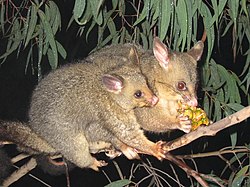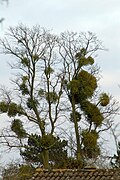Ecological niche
An ecological niche is the part of the environment into which a species fits, and to which it is adapted.[1] A shorthand definition of niche in biology is how an organism makes a living in a place.
However, the term has been used in different ways.[2][3] It is not only a place but a way of life. For example, grazers, insectivores, scavengers and predators can all live their different lifestyles in the same forest. A niche can be occupied by different species in different places even though they 'earn their living' in roughly the same way. Thus the 'bird of prey eating small mammals' niche would in grasslands include the kestrel, but in an oak wood it would be filled by the tawny owl.[4]
The idea of a niche in natural history is ancient: many writers noticed that animals and plants live in places where they are well adapted to live. The word niche was first used in biology by naturalist Roswell Johnson,[5] but in 1917 Joseph Grinnell was the first to use it in a research program.[6] Later, he described the niches of a variety of species.[7] Grinnell was the first to offer the "exclusion principle" in which only one species could occupy a particular niche at any one time.[8][9]

Scientists who study the interactions between living things, such as animals and their environment are called ecologists, and their branch of science is called ecology. A niche is a term which describes a position or opportunity into which some organism fits well. Thus, an ecological niche is a place in nature that is filled by an animal or plant because it is well suited to do so.[10][11][12]
Invasions
When a niche is left open, for example by extinction, other organisms may fill that position.
Also, invasive species of plants and animals in a new land often take over all or part of the niches of native organisms. Sometimes the loss results in the extinction of the natives.[13]
Niche differentiation
In ecology, niche differentiation (also known as niche segregation, niche separation and niche partitioning) is how competing species use the environment differently in a way that helps them to coexist.[14]
Ecological Niche Media
The flightless dung beetle occupies an ecological niche: exploiting animal droppings as a food source.
The shape of the bill of this purple-throated carib is complementary to the shape of the flower and coevolved with it, enabling it to exploit the nectar as a resource.
As a hemi-parasitic plant, the mistletoe in this tree exploits its host for nutrients and as a place to grow.
Duckweed on a pond. Niche differentiation by size: greater duckweed, lesser duckweed and rootless dwarf duckweed
Shorebirds with long legs and long bills, such as these two dowitchers, can feed in slightly deeper water than the semipalmated sandpiper at the water's edge (lower left)
Related pages
References
- ↑ In general use 'niche' means a recess in a wall to hold a small statue, a nook or cranny.
- ↑ Pocheville, Arnaud et al 2015. The ecological niche: history and recent controversies. In Heams, Thomas (ed) Handbook of evolutionary thinking in the sciences. Dordrecht: Springer. pp. 547–586. ISBN 978-94-017-9014-7
- ↑ Three variants of ecological niche are described by Thomas W Schoener; et al. (2009). "§I.1 Ecological niche". In Simon A. Levin (ed.). The Princeton guide to ecology. Princeton University Press. pp. 3 ff. ISBN 9781400833023.
- ↑ McFarland, David 1981. The Oxford companion to animal behaviour. Oxford University Press, Oxford. 411
- ↑ Johnson R.H. 1910. Determinate evolution in the color-pattern of the lady-beetles. Washington WC: Carnegie Institution of Washington.
- ↑ Grinell J. 1917. The niche-relationships of the California thrasher. Auk 34, 427–433
- ↑ Grinnell J. & Storer T.I. 1924. Animal life in the Yosemite: an account of the mammals, birds, reptiles, and amphibians in a cross-section of the Sierra Nevada. Berkeley: University of California Press.
- ↑ Grinnell J. 1928. Presence and absence of animals. University of California Chronicle, 30 , 429–450.
- ↑ Gause G.F. 1934. The struggle for existence. Baltimore: Williams & Wilkins.
- ↑ Mayr, Ernst 2001. What evolution is. Weidenfeld & Nicolson, London. p152
- ↑ Hutchinson G.E. 1978. An introduction to population ecology. New Haven: Yale University Press.
- ↑ Merrell, David J. 1981. Ecological genetics. U of Minnesota Press, 248-250. ISBN 978-0-8166-1019-8.
- ↑ Elton C.S. 1958. The ecology of invasions by animals and plants. Chapman & Hall, London.
- ↑ Niche differentiation: Jessica Harwood, Douglas Wilkin (August, 2018). "Habitat and Niche". Retrieved from https://www.ck12.org/biology/habitat-and-niche/lesson/Habitat-and-Niche-MS-LS/.









